
Illustrative Math Alignment: Grade 6 Unit 1
Arithmetic in Base Ten
Lesson 6: Methods for Multiplying Decimals
Use the following Media4Math resources with this Illustrative Math lesson.
| Thumbnail | Title | Description | Curriculum Nodes |
|---|---|---|---|
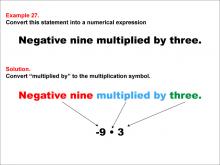
|
Math Example: Language of Math--Numerical Expressions--Multiplication--Example 27 | Math Example: Language of Math--Numerical Expressions--Multiplication--Example 27TopicNumerical Expressions DescriptionThis example illustrates how to convert the phrase "Negative nine multiplied by three" into a numerical expression. The solution demonstrates that "multiplied by" is directly translated to the multiplication symbol, resulting in the expression -9 * 3. This example emphasizes the importance of maintaining the order of terms when converting verbal statements to mathematical notation. |
Numerical Expressions |

|
Math Example: Language of Math--Numerical Expressions--Multiplication--Example 27 | Math Example: Language of Math--Numerical Expressions--Multiplication--Example 27TopicNumerical Expressions DescriptionThis example illustrates how to convert the phrase "Negative nine multiplied by three" into a numerical expression. The solution demonstrates that "multiplied by" is directly translated to the multiplication symbol, resulting in the expression -9 * 3. This example emphasizes the importance of maintaining the order of terms when converting verbal statements to mathematical notation. |
Numerical Expressions |
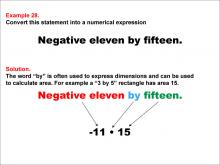
|
Math Example: Language of Math--Numerical Expressions--Multiplication--Example 28 | Math Example: Language of Math--Numerical Expressions--Multiplication--Example 28TopicNumerical Expressions DescriptionThis example demonstrates the conversion of the phrase "Negative eleven by fifteen" into a numerical expression. The solution explains that the word "by" is often used to express dimensions and can indicate multiplication, especially when calculating area. The resulting expression is -11 * 15, showing how everyday language can be translated into precise mathematical notation. |
Numerical Expressions |

|
Math Example: Language of Math--Numerical Expressions--Multiplication--Example 28 | Math Example: Language of Math--Numerical Expressions--Multiplication--Example 28TopicNumerical Expressions DescriptionThis example demonstrates the conversion of the phrase "Negative eleven by fifteen" into a numerical expression. The solution explains that the word "by" is often used to express dimensions and can indicate multiplication, especially when calculating area. The resulting expression is -11 * 15, showing how everyday language can be translated into precise mathematical notation. |
Numerical Expressions |
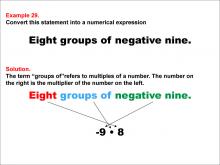
|
Math Example: Language of Math--Numerical Expressions--Multiplication--Example 29 | Math Example: Language of Math--Numerical Expressions--Multiplication--Example 29TopicNumerical Expressions DescriptionThis example illustrates the conversion of the phrase "Eight groups of negative nine" into a numerical expression. The solution demonstrates that "groups of" indicates multiplication, with the resulting expression being -9 * 8. This example emphasizes the importance of recognizing verbal cues that signify mathematical operations. |
Numerical Expressions |

|
Math Example: Language of Math--Numerical Expressions--Multiplication--Example 29 | Math Example: Language of Math--Numerical Expressions--Multiplication--Example 29TopicNumerical Expressions DescriptionThis example illustrates the conversion of the phrase "Eight groups of negative nine" into a numerical expression. The solution demonstrates that "groups of" indicates multiplication, with the resulting expression being -9 * 8. This example emphasizes the importance of recognizing verbal cues that signify mathematical operations. |
Numerical Expressions |
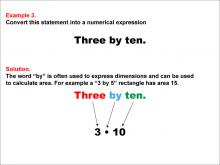
|
Math Example: Language of Math--Numerical Expressions--Multiplication--Example 3 | Math Example: Language of Math--Numerical Expressions--Multiplication--Example 3TopicNumerical Expressions DescriptionThis example illustrates how the phrase "Three by ten" is converted into the numerical expression 3 * 10. It demonstrates that the word "by" is often used to express dimensions and can indicate multiplication, especially when calculating area. |
Numerical Expressions |

|
Math Example: Language of Math--Numerical Expressions--Multiplication--Example 3 | Math Example: Language of Math--Numerical Expressions--Multiplication--Example 3TopicNumerical Expressions DescriptionThis example illustrates how the phrase "Three by ten" is converted into the numerical expression 3 * 10. It demonstrates that the word "by" is often used to express dimensions and can indicate multiplication, especially when calculating area. |
Numerical Expressions |
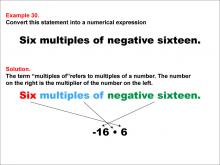
|
Math Example: Language of Math--Numerical Expressions--Multiplication--Example 30 | Math Example: Language of Math--Numerical Expressions--Multiplication--Example 30TopicNumerical Expressions DescriptionThis example demonstrates the conversion of the phrase "Six multiples of negative sixteen" into a numerical expression. The solution explains that "multiples of" indicates multiplication, with the resulting expression being -16 * 6. This example highlights how verbal mathematical statements can be concisely represented symbolically. |
Numerical Expressions |

|
Math Example: Language of Math--Numerical Expressions--Multiplication--Example 30 | Math Example: Language of Math--Numerical Expressions--Multiplication--Example 30TopicNumerical Expressions DescriptionThis example demonstrates the conversion of the phrase "Six multiples of negative sixteen" into a numerical expression. The solution explains that "multiples of" indicates multiplication, with the resulting expression being -16 * 6. This example highlights how verbal mathematical statements can be concisely represented symbolically. |
Numerical Expressions |
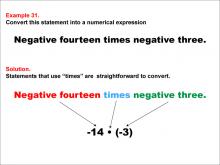
|
Math Example: Language of Math--Numerical Expressions--Multiplication--Example 31 | Math Example: Language of Math--Numerical Expressions--Multiplication--Example 31TopicNumerical Expressions Description
This example demonstrates how to convert the verbal statement "Negative fourteen times negative three" into a numerical expression. The solution shows that this statement translates to -14 * (-3). This example highlights the importance of understanding how to interpret negative numbers in multiplication. |
Numerical Expressions |

|
Math Example: Language of Math--Numerical Expressions--Multiplication--Example 31 | Math Example: Language of Math--Numerical Expressions--Multiplication--Example 31TopicNumerical Expressions Description
This example demonstrates how to convert the verbal statement "Negative fourteen times negative three" into a numerical expression. The solution shows that this statement translates to -14 * (-3). This example highlights the importance of understanding how to interpret negative numbers in multiplication. |
Numerical Expressions |
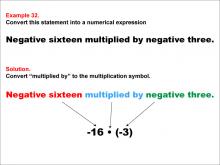
|
Math Example: Language of Math--Numerical Expressions--Multiplication--Example 32 | Math Example: Language of Math--Numerical Expressions--Multiplication--Example 32TopicNumerical Expressions DescriptionThis example illustrates the conversion of the phrase "Negative sixteen multiplied by negative three" into a numerical expression. The solution demonstrates that this verbal statement translates to -16 * (-3). This example emphasizes the importance of correctly interpreting the phrase "multiplied by" in the context of negative numbers. |
Numerical Expressions |

|
Math Example: Language of Math--Numerical Expressions--Multiplication--Example 32 | Math Example: Language of Math--Numerical Expressions--Multiplication--Example 32TopicNumerical Expressions DescriptionThis example illustrates the conversion of the phrase "Negative sixteen multiplied by negative three" into a numerical expression. The solution demonstrates that this verbal statement translates to -16 * (-3). This example emphasizes the importance of correctly interpreting the phrase "multiplied by" in the context of negative numbers. |
Numerical Expressions |
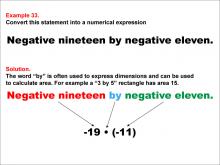
|
Math Example: Language of Math--Numerical Expressions--Multiplication--Example 33 | Math Example: Language of Math--Numerical Expressions--Multiplication--Example 33TopicNumerical Expressions DescriptionThis example demonstrates how to convert the statement "Negative nineteen by negative eleven" into a numerical expression. The solution explains that the word "by" is often used to express dimensions and can be used to calculate area. In this case, it translates to multiplication, resulting in the expression -19 * (-11). |
Numerical Expressions |

|
Math Example: Language of Math--Numerical Expressions--Multiplication--Example 33 | Math Example: Language of Math--Numerical Expressions--Multiplication--Example 33TopicNumerical Expressions DescriptionThis example demonstrates how to convert the statement "Negative nineteen by negative eleven" into a numerical expression. The solution explains that the word "by" is often used to express dimensions and can be used to calculate area. In this case, it translates to multiplication, resulting in the expression -19 * (-11). |
Numerical Expressions |

|
Math Example: Language of Math--Numerical Expressions--Multiplication--Example 34 | Math Example: Language of Math--Numerical Expressions--Multiplication--Example 34TopicNumerical Expressions DescriptionThis example illustrates how to convert the statement "Negative thirteen groups of negative nineteen" into a numerical expression. The solution explains that the term "groups of" refers to multiples of a number, with the number on the right being the multiplier of the number on the left. This results in the expression -19 * (-13). |
Numerical Expressions |

|
Math Example: Language of Math--Numerical Expressions--Multiplication--Example 34 | Math Example: Language of Math--Numerical Expressions--Multiplication--Example 34TopicNumerical Expressions DescriptionThis example illustrates how to convert the statement "Negative thirteen groups of negative nineteen" into a numerical expression. The solution explains that the term "groups of" refers to multiples of a number, with the number on the right being the multiplier of the number on the left. This results in the expression -19 * (-13). |
Numerical Expressions |
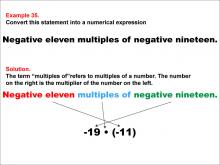
|
Math Example: Language of Math--Numerical Expressions--Multiplication--Example 35 | Math Example: Language of Math--Numerical Expressions--Multiplication--Example 35TopicNumerical Expressions DescriptionThis example demonstrates how to convert the phrase "Negative eleven multiples of negative nineteen" into a numerical expression. The solution explains that the term "multiples of" refers to multiples of a number, with the number on the right being the multiplier of the number on the left. This results in the expression -19 * (-11). |
Numerical Expressions |

|
Math Example: Language of Math--Numerical Expressions--Multiplication--Example 35 | Math Example: Language of Math--Numerical Expressions--Multiplication--Example 35TopicNumerical Expressions DescriptionThis example demonstrates how to convert the phrase "Negative eleven multiples of negative nineteen" into a numerical expression. The solution explains that the term "multiples of" refers to multiples of a number, with the number on the right being the multiplier of the number on the left. This results in the expression -19 * (-11). |
Numerical Expressions |
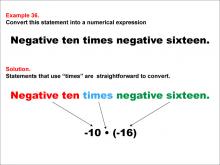
|
Math Example: Language of Math--Numerical Expressions--Multiplication--Example 36 | Math Example: Language of Math--Numerical Expressions--Multiplication--Example 36TopicNumerical Expressions DescriptionThis example illustrates how to convert the statement "Negative ten times negative sixteen" into a numerical expression. The solution explains that statements using "times" are straightforward to convert, resulting in the expression -10 * (-16). This example emphasizes the importance of recognizing common multiplication terminology. |
Numerical Expressions |

|
Math Example: Language of Math--Numerical Expressions--Multiplication--Example 36 | Math Example: Language of Math--Numerical Expressions--Multiplication--Example 36TopicNumerical Expressions DescriptionThis example illustrates how to convert the statement "Negative ten times negative sixteen" into a numerical expression. The solution explains that statements using "times" are straightforward to convert, resulting in the expression -10 * (-16). This example emphasizes the importance of recognizing common multiplication terminology. |
Numerical Expressions |
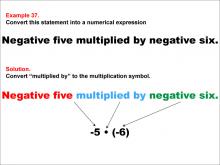
|
Math Example: Language of Math--Numerical Expressions--Multiplication--Example 37 | Math Example: Language of Math--Numerical Expressions--Multiplication--Example 37TopicNumerical Expressions DescriptionThis example demonstrates how to convert the phrase "Negative five multiplied by negative six" into a numerical expression. The solution shows that this statement translates to -5 * (-6). This example highlights the importance of understanding how to interpret the phrase "multiplied by" when dealing with negative numbers. |
Numerical Expressions |

|
Math Example: Language of Math--Numerical Expressions--Multiplication--Example 37 | Math Example: Language of Math--Numerical Expressions--Multiplication--Example 37TopicNumerical Expressions DescriptionThis example demonstrates how to convert the phrase "Negative five multiplied by negative six" into a numerical expression. The solution shows that this statement translates to -5 * (-6). This example highlights the importance of understanding how to interpret the phrase "multiplied by" when dealing with negative numbers. |
Numerical Expressions |
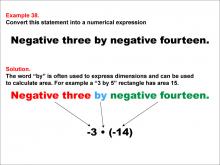
|
Math Example: Language of Math--Numerical Expressions--Multiplication--Example 38 | Math Example: Language of Math--Numerical Expressions--Multiplication--Example 38TopicNumerical Expressions DescriptionThis example demonstrates how to convert the phrase "Negative three by negative fourteen" into a numerical expression. The image uses color coding to break down the verbal statement, helping students understand how to translate words into mathematical symbols. This conversion illustrates the process of transforming "by" into multiplication, resulting in the expression -3 * (-14). |
Numerical Expressions |

|
Math Example: Language of Math--Numerical Expressions--Multiplication--Example 38 | Math Example: Language of Math--Numerical Expressions--Multiplication--Example 38TopicNumerical Expressions DescriptionThis example demonstrates how to convert the phrase "Negative three by negative fourteen" into a numerical expression. The image uses color coding to break down the verbal statement, helping students understand how to translate words into mathematical symbols. This conversion illustrates the process of transforming "by" into multiplication, resulting in the expression -3 * (-14). |
Numerical Expressions |

|
Math Example: Language of Math--Numerical Expressions--Multiplication--Example 39 | Math Example: Language of Math--Numerical Expressions--Multiplication--Example 39TopicNumerical Expressions DescriptionThis example illustrates the conversion of the phrase "Negative eleven groups of negative twelve" into a numerical expression. The image uses visual cues to show how the verbal statement translates into mathematical symbols, resulting in the expression -12 * (-11). This example highlights the importance of understanding the order of multiplication when dealing with negative numbers. |
Numerical Expressions |

|
Math Example: Language of Math--Numerical Expressions--Multiplication--Example 39 | Math Example: Language of Math--Numerical Expressions--Multiplication--Example 39TopicNumerical Expressions DescriptionThis example illustrates the conversion of the phrase "Negative eleven groups of negative twelve" into a numerical expression. The image uses visual cues to show how the verbal statement translates into mathematical symbols, resulting in the expression -12 * (-11). This example highlights the importance of understanding the order of multiplication when dealing with negative numbers. |
Numerical Expressions |
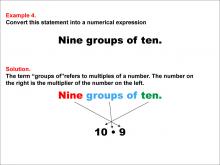
|
Math Example: Language of Math--Numerical Expressions--Multiplication--Example 4 | Math Example: Language of Math--Numerical Expressions--Multiplication--Example 4TopicNumerical Expressions DescriptionThis example demonstrates how the phrase "Nine groups of ten" is converted into the numerical expression 10 * 9. It illustrates that the term "groups of" refers to multiples of a number and is another way to express multiplication. |
Numerical Expressions |

|
Math Example: Language of Math--Numerical Expressions--Multiplication--Example 4 | Math Example: Language of Math--Numerical Expressions--Multiplication--Example 4TopicNumerical Expressions DescriptionThis example demonstrates how the phrase "Nine groups of ten" is converted into the numerical expression 10 * 9. It illustrates that the term "groups of" refers to multiples of a number and is another way to express multiplication. |
Numerical Expressions |
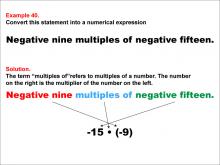
|
Math Example: Language of Math--Numerical Expressions--Multiplication--Example 40 | Math Example: Language of Math--Numerical Expressions--Multiplication--Example 40TopicNumerical Expressions DescriptionThis example demonstrates how to convert the phrase "Negative nine multiples of negative fifteen" into a numerical expression. The image uses color-coded text and arrows to guide students through the process of translating this verbal statement into mathematical symbols, resulting in the expression -15 * (-9). This example emphasizes the importance of understanding the order of factors in multiplication, especially when dealing with negative numbers. |
Numerical Expressions |

|
Math Example: Language of Math--Numerical Expressions--Multiplication--Example 40 | Math Example: Language of Math--Numerical Expressions--Multiplication--Example 40TopicNumerical Expressions DescriptionThis example demonstrates how to convert the phrase "Negative nine multiples of negative fifteen" into a numerical expression. The image uses color-coded text and arrows to guide students through the process of translating this verbal statement into mathematical symbols, resulting in the expression -15 * (-9). This example emphasizes the importance of understanding the order of factors in multiplication, especially when dealing with negative numbers. |
Numerical Expressions |
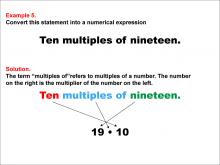
|
Math Example: Language of Math--Numerical Expressions--Multiplication--Example 5 | Math Example: Language of Math--Numerical Expressions--Multiplication--Example 5TopicNumerical Expressions DescriptionThis example illustrates how the phrase "Ten multiples of nineteen" is converted into the numerical expression 19 * 10. It demonstrates that the term "multiples of" indicates multiplication, with the number on the right being multiplied by the number on the left. |
Numerical Expressions |

|
Math Example: Language of Math--Numerical Expressions--Multiplication--Example 5 | Math Example: Language of Math--Numerical Expressions--Multiplication--Example 5TopicNumerical Expressions DescriptionThis example illustrates how the phrase "Ten multiples of nineteen" is converted into the numerical expression 19 * 10. It demonstrates that the term "multiples of" indicates multiplication, with the number on the right being multiplied by the number on the left. |
Numerical Expressions |
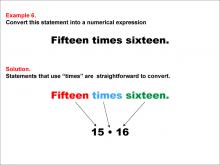
|
Math Example: Language of Math--Numerical Expressions--Multiplication--Example 6 | Math Example: Language of Math--Numerical Expressions--Multiplication--Example 6TopicNumerical Expressions DescriptionThis example demonstrates how the phrase "Fifteen times sixteen" is converted into the numerical expression 15 * 16. It illustrates that the word "times" is a straightforward indicator of multiplication in mathematical language. |
Numerical Expressions |

|
Math Example: Language of Math--Numerical Expressions--Multiplication--Example 6 | Math Example: Language of Math--Numerical Expressions--Multiplication--Example 6TopicNumerical Expressions DescriptionThis example demonstrates how the phrase "Fifteen times sixteen" is converted into the numerical expression 15 * 16. It illustrates that the word "times" is a straightforward indicator of multiplication in mathematical language. |
Numerical Expressions |
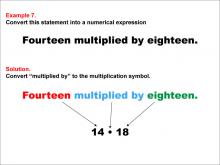
|
Math Example: Language of Math--Numerical Expressions--Multiplication--Example 7 | Math Example: Language of Math--Numerical Expressions--Multiplication--Example 7TopicNumerical Expressions DescriptionThis example illustrates how the phrase "Fourteen multiplied by eighteen" is converted into the numerical expression 14 * 18. It demonstrates that the term "multiplied by" is directly translated to the multiplication symbol in mathematical notation. |
Numerical Expressions |

|
Math Example: Language of Math--Numerical Expressions--Multiplication--Example 7 | Math Example: Language of Math--Numerical Expressions--Multiplication--Example 7TopicNumerical Expressions DescriptionThis example illustrates how the phrase "Fourteen multiplied by eighteen" is converted into the numerical expression 14 * 18. It demonstrates that the term "multiplied by" is directly translated to the multiplication symbol in mathematical notation. |
Numerical Expressions |
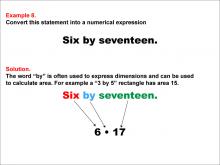
|
Math Example: Language of Math--Numerical Expressions--Multiplication--Example 8 | Math Example: Language of Math--Numerical Expressions--Multiplication--Example 8TopicNumerical Expressions DescriptionThis example demonstrates how to convert the phrase "Six by seventeen" into a numerical expression. The word "by" is often used to express dimensions and can be used to calculate area. In this case, it indicates multiplication, resulting in the expression 6 * 17. |
Numerical Expressions |

|
Math Example: Language of Math--Numerical Expressions--Multiplication--Example 8 | Math Example: Language of Math--Numerical Expressions--Multiplication--Example 8TopicNumerical Expressions DescriptionThis example demonstrates how to convert the phrase "Six by seventeen" into a numerical expression. The word "by" is often used to express dimensions and can be used to calculate area. In this case, it indicates multiplication, resulting in the expression 6 * 17. |
Numerical Expressions |

|
Math Example: Language of Math--Numerical Expressions--Multiplication--Example 9 | Math Example: Language of Math--Numerical Expressions--Multiplication--Example 9TopicNumerical Expressions DescriptionThis example illustrates how to convert the phrase "Twelve groups of seven" into a numerical expression. The term "groups of" refers to multiples of a number, indicating multiplication. In this case, it translates to the expression 7 * 12. |
Numerical Expressions |

|
Math Example: Language of Math--Numerical Expressions--Multiplication--Example 9 | Math Example: Language of Math--Numerical Expressions--Multiplication--Example 9TopicNumerical Expressions DescriptionThis example illustrates how to convert the phrase "Twelve groups of seven" into a numerical expression. The term "groups of" refers to multiples of a number, indicating multiplication. In this case, it translates to the expression 7 * 12. |
Numerical Expressions |
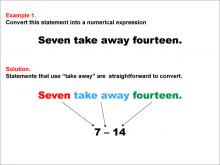
|
Math Example: Language of Math--Numerical Expressions--Subtraction--Example 1 | Math Example: Language of Math--Numerical Expressions--Subtraction--Example 1TopicNumerical Expressions DescriptionThis math example demonstrates how to convert the verbal statement "Seven take away fourteen" into a numerical expression. The phrase "take away" is translated into the subtraction operation, resulting in the expression 7 - 14. |
Numerical Expressions |

|
Math Example: Language of Math--Numerical Expressions--Subtraction--Example 1 | Math Example: Language of Math--Numerical Expressions--Subtraction--Example 1TopicNumerical Expressions DescriptionThis math example demonstrates how to convert the verbal statement "Seven take away fourteen" into a numerical expression. The phrase "take away" is translated into the subtraction operation, resulting in the expression 7 - 14. |
Numerical Expressions |
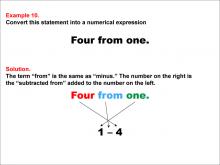
|
Math Example: Language of Math--Numerical Expressions--Subtraction--Example 10 | Math Example: Language of Math--Numerical Expressions--Subtraction--Example 10TopicNumerical Expressions DescriptionThis example shows how to convert the verbal statement "Four from one" into a numerical expression. The word "from" indicates subtraction, leading to the expression 1 - 4. Numerical expressions are vital for translating everyday language into mathematical notation. This collection of examples helps students learn how to interpret various verbal phrases and convert them into accurate mathematical expressions. By exploring different ways to express subtraction, such as using "from," students understand how language affects operations and number order. |
Numerical Expressions |

|
Math Example: Language of Math--Numerical Expressions--Subtraction--Example 10 | Math Example: Language of Math--Numerical Expressions--Subtraction--Example 10TopicNumerical Expressions DescriptionThis example shows how to convert the verbal statement "Four from one" into a numerical expression. The word "from" indicates subtraction, leading to the expression 1 - 4. Numerical expressions are vital for translating everyday language into mathematical notation. This collection of examples helps students learn how to interpret various verbal phrases and convert them into accurate mathematical expressions. By exploring different ways to express subtraction, such as using "from," students understand how language affects operations and number order. |
Numerical Expressions |
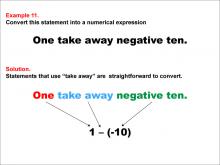
|
Math Example: Language of Math--Numerical Expressions--Subtraction--Example 11 | Math Example: Language of Math--Numerical Expressions--Subtraction--Example 11TopicNumerical Expressions DescriptionThis example involves converting the phrase "One take away negative ten" into a numerical expression. The phrase "take away" indicates subtraction, resulting in the expression 1 - (-10). Understanding numerical expressions is essential as they connect everyday language with mathematical notation. This collection aids students in interpreting various verbal phrases and converting them into precise mathematical expressions. By exploring expressions involving negative numbers, students gain insight into how language influences mathematical operations. |
Numerical Expressions |

|
Math Example: Language of Math--Numerical Expressions--Subtraction--Example 11 | Math Example: Language of Math--Numerical Expressions--Subtraction--Example 11TopicNumerical Expressions DescriptionThis example involves converting the phrase "One take away negative ten" into a numerical expression. The phrase "take away" indicates subtraction, resulting in the expression 1 - (-10). Understanding numerical expressions is essential as they connect everyday language with mathematical notation. This collection aids students in interpreting various verbal phrases and converting them into precise mathematical expressions. By exploring expressions involving negative numbers, students gain insight into how language influences mathematical operations. |
Numerical Expressions |
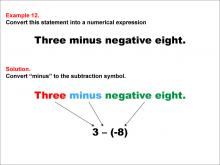
|
Math Example: Language of Math--Numerical Expressions--Subtraction--Example 12 | Math Example: Language of Math--Numerical Expressions--Subtraction--Example 12TopicNumerical Expressions DescriptionThis example demonstrates converting the phrase "Three minus negative eight" into a numerical expression. The word "minus" indicates subtraction, resulting in the expression 3 - (-8). Numerical expressions are crucial for translating everyday language into mathematical notation. This collection helps students learn to interpret various verbal phrases and convert them into accurate mathematical expressions. By exploring expressions involving negatives, students understand how language affects operations. |
Numerical Expressions |

|
Math Example: Language of Math--Numerical Expressions--Subtraction--Example 12 | Math Example: Language of Math--Numerical Expressions--Subtraction--Example 12TopicNumerical Expressions DescriptionThis example demonstrates converting the phrase "Three minus negative eight" into a numerical expression. The word "minus" indicates subtraction, resulting in the expression 3 - (-8). Numerical expressions are crucial for translating everyday language into mathematical notation. This collection helps students learn to interpret various verbal phrases and convert them into accurate mathematical expressions. By exploring expressions involving negatives, students understand how language affects operations. |
Numerical Expressions |